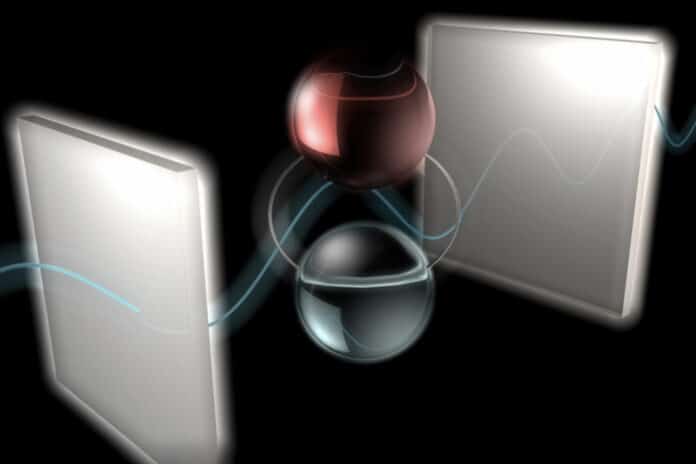By sandwiching tiny flakes of perovskite material between two precisely spaced reflective surfaces, scientists at MIT and elsewhere have created a new device that combines aspects of electronics and photonics. Their findings could lead to the developing of new kinds of devices that efficiently bridge the gap between matter and light.
The scientists could directly control the momentum of some “quasiparticles” in the system by fabricating these perovskite sandwiches and activating them with laser beams. These quasiparticles, sometimes called exciton-polariton pairs, are mixtures of light and matter. The ability to read and write data to devices based on this phenomenon may be made possible by regulating this attribute.
The scientists could directly control the momentum of some “quasiparticles” in the system by fabricating these perovskite sandwiches and activating them with laser beams. These quasiparticles, sometimes called exciton-polariton pairs, are mixtures of light and matter. The ability to read and write data to devices based on this phenomenon may be made possible by regulating this attribute.
MIT recent graduate Madeleine Laitz Ph.D. ’22, said, “What’s particularly fascinating about exciton-polaritons is that they lie “on a spectrum between purely electronic and photonic systems. These quasiparticles have the characteristics of both, and thus you can leverage exciton-polaritons to utilize the best properties of each.”
“For example, purely electronic transistors have inherent losses to capacitance effects at each interface between devices, whereas purely photonic systems have challenges in engineering, in that it’s tough to get photons to interact, and you have to rely on complex interferometric schemes. By contrast, the quasiparticles used by this team can be easily controlled through multiple variables.”
MIT professor Vladimir Bulovic said, “The quasiparticle is a combined state of light and neutral charge. As a result, you can perturb that combined state either with light or charge and hence, if you need to modulate that state, you have extra levers you can utilize. These extra levers can now allow one to manipulate this combined state of matter more energy-efficiently.”
Laitz said, “What’s more, the materials involved are easily manufactured using room-temperature, solution-based processing methods, and thus could be relatively easy to produce at scale once practical systems are designed. So far, the work is very early, as researchers are still studying newly discovered effects; practical applications could be five to 10 years away.”
In particular, scientists chose Halide perovskite because of its excellent properties: It harvests light well and turns photons into electrons or excitons, depending on the dimensionality and material properties of the perovskite.
The scientists then sandwiched microscopic flakes of the substance between mirrored surfaces to produce an optical cavity that can trap light photons. Half the wavelength of light separated the mirrors that this perovskite material absorbs and emits using spacer layers between two ultrathin layers, each just tens of nanometers thick.
Laitz says, “Using perovskite tuned to a wavelength of green light, the emitted green light then bounces back and forth between the mirrors. It’s reabsorbed by the material, re-emitted, reabsorbed, reabsorbed over and over again so quickly that you’re interconverting between the photon and the exciton, such that you generate a superposition of both.”
This can lead to the state of matter known as a Bose-Einstein Condensate, in which all the particles have identical energy states and behave much like one large particle.
Laitz says that such condensates carry a property known as spin, which can be modified by light or electrical stimulation; the resulting changes can be measured by observing photoluminescence from the material using a spectroscopic imaging system. And unlike purely photonic systems, where there is little interaction between photons, these materials have strong interactions with light and electrons.
“Arrays of such condensates have been produced, but typically only at ultralow, cryogenic temperatures. Perovskites offer the opportunity for realizing this phenomenon at elevated temperatures, but it’s hard to form the condensates in perovskites. This new research shows fundamental characteristics of the process that leads to condensation. In their paper, we propose several strategies from a material perspective and a device architecture perspective to enable this. And that could be a key step toward eventual room-temperature qubits.”
Postdoc Dane deQuilettes said, “While such devices may take several years to develop, a more near-term application of the new findings could be in producing new kinds of light-emitting devices, including ones that could provide a steerable light source with a directional output that can be controlled electronically.”
Stéphane Kéna-Cohen, an associate professor of engineering physics at the Montreal Polytechnic, said, “There has been quite a bit of interest in using exciton-polaritons as the basis for low-power coherent light sources, similar to lasers. In that area, the challenge is to get polaritons to relax efficiently to their lowest energy state. This paper helps us understand how this happens in perovskite microcavities and how to design cavities better to make this happen at very low power.”
Journal Reference:
- Laitz, M., Kaplan, A.E.K., Deschamps, J. et al. Uncovering temperature-dependent exciton-polariton relaxation mechanisms in hybrid organic-inorganic perovskites. Nat Commun 14, 2426 (2023). DOI: 10.1038/s41467-023-37772-7
